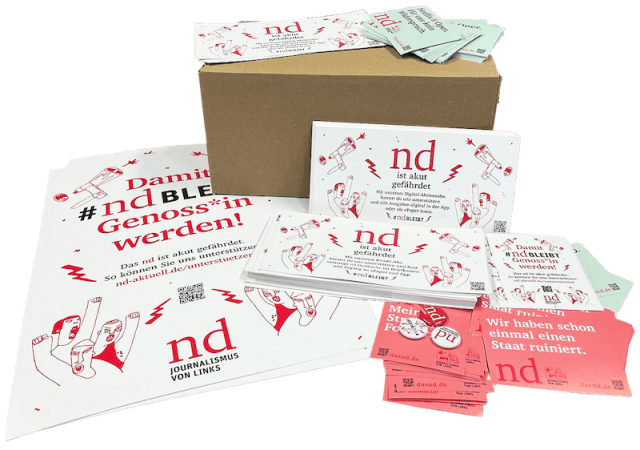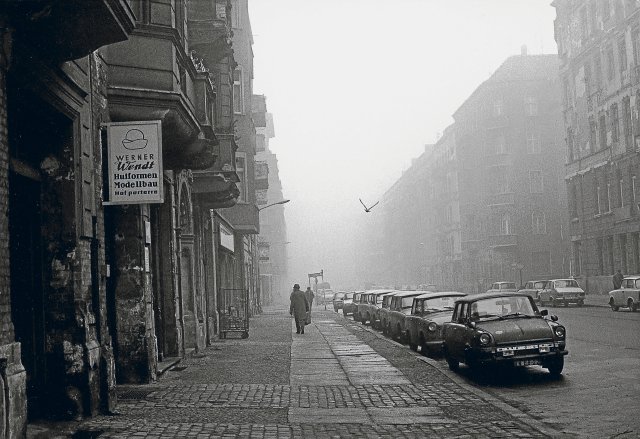Helga Paris, “Winsstrasse with Pigeon”, 70s. From the series “Berlin 1974–82”
Photo: Helga Paris. Source: ifa (Institute for Foreign Relations)
When Helga Paris stepped up to the microphone at the opening of her solo exhibition at the Berlin Academy of Arts on Pariser Platz on September 7, 2019, she appeared fragile. Some were already worried about the photographer, who was known far beyond the country’s borders at the time. Nevertheless, she laughed, was visibly pleased by the large audience and was as gentle and friendly as she had always been described by many friends and admirers. With this probably largest solo exhibition with 275 photos in four halls of the academy, of which she had been a member since 1996 and to which she had bequeathed her work, she was once again given a big boost. The core of Helga Paris’ photography consists of portraits of people around her. She also took street photography and pictures with which she documented the arduous work of professional groups such as garbage drivers and textile workers. Ultimately, her photographs are evidence of a vanished world, because not only did the GDR disappear, but with it the people of the various milieus that existed in East Berlin and other East German cities. They are long dead or have been driven out of their neighborhoods due to restitution and gentrification.
Helga Paris was born Helga Steffens on May 21, 1938 in Gollnow, Pomerania, grew up in Zossen and later took the surname of her husband, the painter Ronald Paris. From 1956 to 1960 she studied fashion design at the clothing college in Berlin and completed an internship at VEB Treffmodelle to make coats. She then worked as a lecturer in costume studies and as a commercial artist. Photography always played a role in these professional fields, but Helga Paris learned how to use the medium autodidactically in the mid-1960s. She also worked as a photo laboratory assistant for a few years, which gave her all the necessary knowledge for her self-determined photography. At the beginning it was probably primarily an interest in documenting one’s own family and the children’s growth, remembers the photographer and publisher Hansgert Lambers, who was a friend of Paris and wrote the book “DDR. Photographing Women” was published in 1989 by his ex-Pose publishing house. Of course it also included photographs by Helga Paris.
Paris’s radius had gradually expanded beyond the family. There were also the neighbors and the immediate surroundings on Winsstrasse, where she lived with her husband and two children Robert and Jenny. The Prenzlauer Berg area was primarily characterized by a proletarian milieu that photographed Paris; She also took a series of photographs in the workers’ bars. She also maintained contact with the art scene and photographed, for example, the painter Nuria Quevedo and authors such as Christa Wolf and Elke Erb.
In 1970, Paris took the plunge into becoming a freelance photographer. Stage photography for productions by Benno Besson, photo series in Georgia, Poland and also a critical inventory in Halle of the state of the city, which the party and city leaders were not amused about. Her approach was to “photograph Halle like a foreign city in a foreign country – trying to forget everything I could know and understand. As if I had photographed in Rome, for example.” The pictures were then not allowed to be exhibited or published; it would have been tantamount to an oath of disclosure for those politically responsible.
When the punks appeared in East Berlin at the end of the 70s, Paris was initially afraid of their martial appearance, as she said in an interview with Deutschlandradio in 2019. The bridge to this rebellious pop culture was built by her children, who were enthusiastic about it and brought home punk friends. This is how wonderful portraits were created of them too. In an interview, Paris was visibly touched by the politeness of a punk she portrayed in her apartment. He held a hand under his burning butt so that no ashes would fall to the ground.
The author Annett Gröschner confirms that Helga Paris’ portraits not only show the person depicted, but that she herself is reflected in their looks. »You see familiarity in the eyes of those photographed, never arrogance or condescension; Helga Paris never abused the strength she had as power. Nobody was asked to laugh,” says Gröschner. A compliment could hardly be greater. And in fact, Paris’ kindness and open and curious nature were the key to the people she captured with her camera. With this style she must have also managed to take photos in the dangerous train station environment of Rome.
Helga Paris took an atmospheric photograph of the hazy Winsstrasse in 1970. You can see it: the shop sign “Werner Wendt. Hat shapes model making”, a few passers-by, parked Trabis and a pigeon flying down the middle of the street. The picture was taken at the beginning of his career and shows a great sense of the right moment. It was there, in her apartment on Winsstrasse, that the great chronicler of a vanished world died on Monday, February 5, 2024, at the age of 85.
#ndstays – Get active and order a promotional package

Regardless of whether it is pubs, cafés, festivals or other meeting places – we want to become more visible and reach everyone who values independent journalism with an attitude. We have put together a campaign package with stickers, flyers, posters and buttons that you can use to get active and support your newspaper.
To the promotional package
judi bola online link sbobet sbobet sbobet
